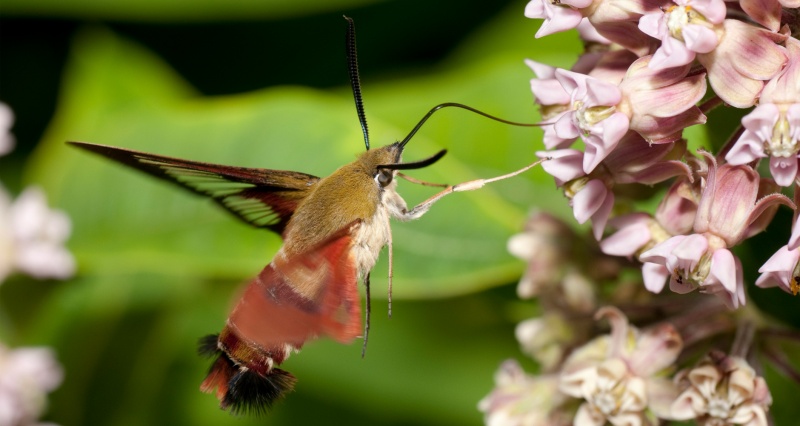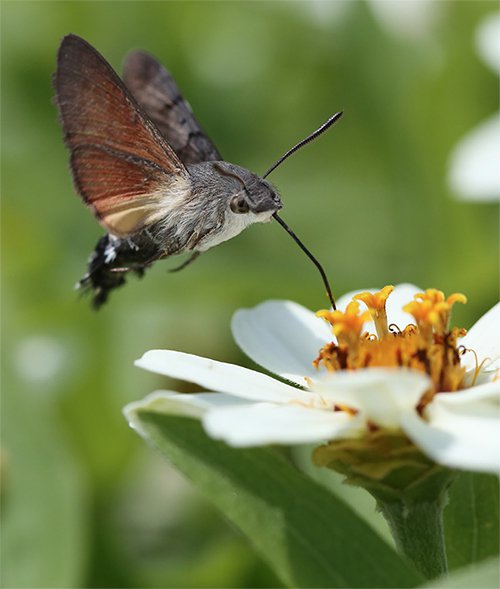By: Reba Kocher
Listen to this blog post here: Hummingbird Moths.mp3

A hornworm caterpillar aka the tomato plant's worst nightmare
Have you ever seen those scary, bright green Hornworm Caterpillars in your tomato garden? They eat through whole stalks--leaving you with nothing. They are a gardener’s nightmare! They ate their way through my entire tomato garden last year, and I was outside every single day picking them off of my plants. As annoying as they are as caterpillars, they metamorphosize into awesome moths called Hummingbird Moths, or sometimes called Bee Hawk-Moths.
Hummingbird Moths are found in North America, Europe, Asia, and Africa. In the United States, we have two common species: the Snowberry Clearwing and the Hummingbird Clearwing.The Snowberry Clearwings are more commonly seen in the western United States, while the Hummingbird Clearwings are more commonly seen in the eastern United States--like Ohio. They have heavy, stout bodies and long front wings. They are generally a reddish-brown color, but some of them are colored more similarly to bees. Hummingbird Moths, like other lepidoptera, have scales covering their wings. Some species, however, lose many of their scales (hence the name clearwing). They can be found in open meadows, forest edges, and, of course, your gardens. So why are they called a Hummingbird Moth, you ask? Well.. they look and act so similarly to hummingbirds that, unless you are trained to spot the differences, you might mistake one of these moths for an actual Hummingbird!

A photo of a Hummingbird Moth drinking nectar. You can see through his wings, which means that he has lost some of his scales.

Another image of a Hummingbird Moth with his proboscis out and his scales more easily seen.
Hummingbird Moths fly and move just like Hummingbirds. They can beat their wings up to 70 beats per second and can fly as fast as 12 MPH. Unlike other moths, they fly during the day, and they can remain suspended in the air as they unfurl their proboscis (feeding tube) and eat nectar from flowers. They will eat from a variety of flowers species, but they are likely to be spotted near bee balm, phlox, verbena, and honeysuckle. They tend to lay their eggs on the bottom of honeysuckle, dogbane, hawthorne, cherry, and plum leaves. This is because these are larval food plants. It is possible to see adult Hummingbird Moths flying in early spring, but it is more common for you to see them in the summertime as the bee balm begins to bloom. As adults, just like other lepidoptera, they are pollinators. So even though we tend to hate those fat, green caterpillars, do not kill them! We need them to transform into Hummingbird Moths and pollinate as many native plants as they can!
Fun Fact: I’m sure many of you have seen Silence of the Lambs (1991), and if you remember, Hannibal Lecter placed the cocoon of the Death’s Head Hawk Moth in the mouths of his victims. That Hawk Moth is related to the Hummingbird Moth! They had hornworms on the set too! Read about the glamorous lives of these caterpillars and moths here: https://www.imdb.com/title/tt0102926/
References & Further Reading:
https://www.massaudubon.org/learn/nature-wildlife/insects-arachnids/hummingbird-moth-clearwing-moth
https://www.farmersalmanac.com/hummingbird-moth-32556
https://www.fs.fed.us/wildflowers/pollinators/pollinator-of-the-month/hummingbird_moth.shtml
https://butterflywebsite.com/articles/hummingbird-moths.cfm
https://www.insectidentification.org/insect-description.asp?identification=Hummingbird-Moth
Columbus Dispatch article on them: https://www.dispatch.com/article/20130803/LIFESTYLE/308039736
Information about them in Ohio: https://trekohio.com/2016/04/19/the-hummingbird-moth/
